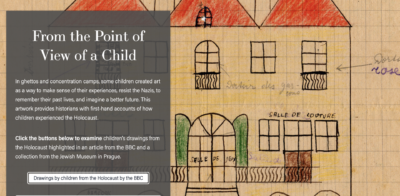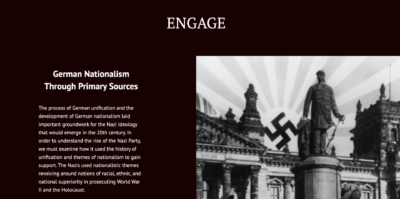Experiencing the pivot: building a virtual internship program (Part III)
12 November 2020 – Adina Langer
Editor’s Note: This post is the third in a series of three describing the experiences of staff and interns participating in a new virtual internship program at the Museum of History and Holocaust Education (MHHE) at Kennesaw State University, created as a response to the COVID-19 pandemic. (The first post featured an interview with MHHE internship coordinator Tyler Crafton-Karnes and the second post began the interviews with the interns themselves.) The content of this post is based on responses to questions posed by MHHE curator Adina Langer to interns Mason Allen, Amy Collerton, Alejandra Gonzalez-Calvo, and Alysa Matsunaga.
Part III
When asked to describe their ideal virtual internships, the four students offered important insights. Allen said, “My ideal virtual internship would involve working closely and interacting with a public audience. For me, education is one of the most important missions of public history. Outside of COVID-19, my ideal internship would involve performing curatorial duties in a history museum as well as interacting face-to-face with the public.”

Still from Adobe Spark page created by intern Alysa Matsunaga. Image credit: Alysa Matsunaga
Gonzalez-Calvo was happy with her virtual internship experience but recommended “more one-on-one or small-group Zoom meetings” to make the best use of everyone’s time. Matsunaga’s ideal virtual internship would “emphasize communication between the staff and the interns, using meetings to create opportunities for networking and adapting tasks, like researching, to be online.” Matsunaga felt that her summer internship with the MHHE did just that.
Likewise, Collerton felt that “working to create online exhibits and lessons for the MHHE has been a very rewarding experience and has provided me with unique insights into what goes into picking sources and items for exhibits. The ideal virtual internship is one that allows interns to work on projects that are considered equally important to the museum as physical exhibits . . . I believe it is important that the permanent staff of the museum make it clear to the virtual interns that the skills they are developing through the virtual internship will be important in their permanent careers.”
Asked to share how the pandemic has changed their views about the future of their careers, the interns offered an honest assessment. Collerton said, “the outlook for museums and places of public history is, currently, bleak. Though I still hope to find work in a public history institution, I must come to terms with the fact that the timetable for doing so has been extended at least a year and possibly indefinitely. While the pandemic has not changed my hopes for my eventual career, it has forced me to reevaluate the ways in which I expected to achieve my goals and the length of time that I thought achieving those goals would take.”

An Adobe Spark project created for the MHHE by intern Mason Allen. Image credit: Mason Allen.
Similarly, Allen has reevaluated his career prospects. “I’ve had to think of other possible avenues for work in the future. Given the extensive closures of public spaces, I feel compelled to entertain the possibility that many museums may not be hiring once I graduate. I’ve considered returning to teaching, as well as going into professional research and certain fields of consulting.”
Less far along in their educational journeys, Matsunaga said, “The pandemic has made me realize how flexible I will have to be to pursue a museum career. A major issue that’s been brought up to me when I was interviewing the MHHE staff was the increased dependency on grants to fund the museum’s programs, as well as maintaining interest from the general public to keep the museum active. This made me realize that I will have to work twice as hard and learn to diversify my skills to obtain the career that I want.” Gonzalez-Calvo felt that the pandemic has given her an opportunity to re-focus. “I used a lot of the quarantine time painting, something I plan on continuing as I further my academic studies. I’ve become steadfast in my career choices.”
The Q&A concluded with an opportunity for each intern to offer advice to employers who want to start a successful virtual public history internship program during the pandemic and beyond. The Museum of History and Holocaust Education is located within Kennesaw State University, providing a built-in partnership with an academic public history program. However, this advice can also apply to stand-alone museums and historic sites, especially if they are able to connect with academic partners. Gonzalez-Calvo suggests, “Hire a great team of mentors with different expertise backgrounds. Everyone will want something different out of an internship, and if you have a diversity of careers within your public history program, everyone will come out being able to adapt to many different roles within museum education and public history.”
Allen said, “A great attraction would be to offer opportunities for professional development that could help students build essential skills as they prepare to enter the job market. If the institution has the funds, a wage or stipend would also be a great draw and would contribute to healthy morale.” Matsunaga reflected, “For future virtual internships to be successful, they should have employees that are readily available to communicate with the interns, as being virtual makes everyone in the internship more dependent on long-distance communication to keep the internship going. This means that interns should be able to know where they can find the employee’s email, phone number, and so on.
Matsunaga also commented that “wherever the internship is taking place, I would recommend that a virtual tour should be available, if possible, so that interns will have a sense of where they would have been interning if the internship was in-person. A set schedule or timetable for the duration of the internship would also help create a successful internship, as it will add structure to an internship that doesn’t have a set time or place to work at. Lastly, for a virtual internship about public history, if the internship focuses on research, the employers should direct and advise interns on accessible, public resources, especially when there are resources connected with the university or museum.”
Finally, Collerton emphasized that “face to face communication is essential. Naturally, that is harder to achieve with social distancing restrictions, but it can still be achieved through Zoom meetings. The MHHE has also worked to make their virtual internship as similar as possible to a physical internship. For instance, professional development workshops are part of the weekly internship check-in meetings, and the interns are asked to interview at least four members of staff to both gain insight into the day to day workings of a museum and build their network as much as possible given the restrictions currently in place. The projects given to the virtual interns have had clear missions behind them and have been held in equally high esteem as other projects undertaken by the MHHE. By ensuring that the value of the internship remains the same, a virtual internship can be just as rewarding as an in-person one.”
~The Museum of History and Holocaust Education (MHHE) at Kennesaw State University presents public events, exhibits, and educational resources focused on World War II and the Holocaust in an effort to promote education and dialogue about the past and its significance today.



